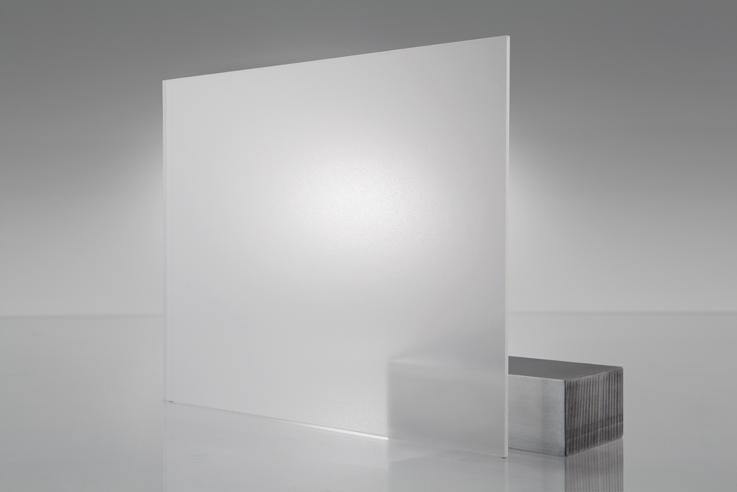- Products & Services
Products & Services
Core Offerings
Materials
Product Brands
- Industry
- Catalog
- Where to Buy
-
 OPTIX® NG - Non-Glare Acrylic Light Matte
OPTIX® NG - Non-Glare Acrylic Light Matte
OPTIX NG Light Matte is a non-glare acrylic sheet ideal for signage, silk-screening, and point-of-purchase displays. Unlike glass, it's shatter-resistant and lightweight, which makes it ideal for glazing in large frames or any situation where shattering glass would be a safety concern. Available in a variety of stock sizes, thicknesses and protective masking options.
Run-to-Size Capabilities
- THICKNESS 0.080" – 0.177"
- WIDTH 5" – 60"
- LENGTH 10" – 216"
- Translucent
- Indoor
- Outdoor

Available Colors
View More +
View Less —
Custom colors available.
**Colors on screen may not reflect exact matches to physical sheets.
*Non-Stock colors, patterns or sizes may require a minimum quantity order.
Features & Benefits
View More +
View Less —
Reduces glare and surface reflections
Available in Heavy Matte & Light Matte finishes
| REQUEST | ITEM # | COLORS | PATTERN/TEXTURES | MASKING | THICKNESS (in.) | SIZE (in.) | SQ FT | PACK QTY | SKID QTY |
|---|---|---|---|---|---|---|---|---|---|
| 625017-1 | Clear | Non-Glare - Light Matte | TG Paper Replacement Film | .080 | 48” x 96” | 32 | 100 | ||
| 625203-1 | Clear | Non-Glare - Light Matte | Papermask | .080 | 48” x 96” | 32 | 100 | ||
| 625007-1 | Clear | Non-Glare - Light Matte | Adhesive Polyfilm | .100 | 48” x 96” | 32 | 100 | ||
| 625015-1 | Clear | Non-Glare - Light Matte | TG Paper Replacement Film | .118 | 48” x 96” | 32 | 80 | ||
| 11-0060213 | Clear | Non-Glare - Light Matte | Adhesive Polyfilm | .125 | 60” x 96” | 40 | 70 | ||
| 625008-1 | Clear | Non-Glare - Light Matte | Adhesive Polyfilm | .125 | 48” x 96” | 32 | 80 | ||
| 625303-1 | Clear | Non-Glare - Light Matte | Papermask | .125 | 48” x 96” | 32 | 80 |
Physical |
TEST METHOD |
UNITS |
OPTIX NG Non-Glare |
|---|---|---|---|
Specific Gravity/Relative Density |
ASTM D792 |
1.19 |
|
Optical Refractive Index |
ASTM D542 |
1.49 |
|
Sound Transmission |
ASTM E90 / E413 |
dB |
27 |
Water Absorption |
ASTM D570 |
% |
0.4 |
Mold Shrinkage |
ASTM D955 |
mils/in |
2-6 |
Mechanical |
TEST METHOD |
UNITS |
OPTIX NG Non-Glare |
|---|---|---|---|
Tensile Strength |
ASTM D638 |
psi |
11,030 |
Tensile Elongation – Max. |
ASTM D638 |
% |
5.8 |
Tensile Modulus of Elasticity |
ASTM D638 |
psi |
490,000 |
Flexural Strength |
ASTM D790 |
psi |
17,000 |
Flexural Modulus of Elasticity |
ASTM D790 |
psi |
490,000 |
Izod Impact Strength – Molded Notch |
ASTM D256 |
ft-lb/in Notch |
0.4 |
Izod Impact Strength – Milled Notch |
ASTM D256 |
ft-lb/in Notch |
0.28 |
Tensile Impact Strength |
ASTM D1822 |
ft-lb/in2 |
20 |
Abrasion Resistance - Change in Haze - 0 cycles |
ASTM D1044 |
Haze, % |
0 |
Abrasion Resistance - Change in Haze - 10 cycles |
ASTM D1044 |
Haze, % |
11.2 |
Abrasion Resistance - Change in Haze - 50 cycles |
ASTM D1044 |
Haze, % |
24 |
Abrasion Resistance - Change in Haze - 200 cycles |
ASTM D1044 |
Haze, % |
24.9 |
Rockwell Hardness |
ASTM D785 |
M-95 |
Thermal |
TEST METHOD |
UNITS |
OPTIX NG Non-Glare |
|---|---|---|---|
Maximum Recommended Continuous Service Temperature |
°F |
170-190 |
|
Softening Temperature |
°F |
210-220 |
|
Melting Temperature |
°F |
300-315 |
|
Deflection Temperature @ 264 psi (1.8 MPa) |
ASTM D648 |
°F |
203 |
Deflection Temperature @ 66 psi (0.45 MPa) |
ASTM D648 |
°F |
207 |
Coefficient of Thermal Expansion |
ASTM D696 |
in/in/°F |
3.0x10-5 |
Thermal Conductivity |
ASTM C177 |
BTU-ft/ft2/hr/°F |
0.075 |
Flammability (Burning Rate) |
ASTM D635 |
in/minute |
1.019 |
Flammability |
UL 94 |
HB |
|
Smoke Density Rating |
ASTM D2843 |
% |
3.4 |
Self-Ignition Temperature |
ASTM D1929 |
°F |
833 |
Flame Spread Index |
ASTM E84 |
115 |
|
Smoke Developed Index |
ASTM E84 |
550 |
Chemical |
TEST METHOD |
UNITS |
OPTIX NG Non-Glare |
|---|---|---|---|
Resistance to Stress - Critical Crazing Stress to: Isopropyl Alcohol |
ARTC Modification of MIL-P6997 |
psi |
900 |
Resistance to Stress - Critical Crazing Stress to: Lacquer Thinner |
ARTC Modification of MIL-P6997 |
psi |
500 |
Resistance to Stress - Critical Crazing Stress to: Toluene |
ARTC Modification of MIL-P6997 |
psi |
1,300 |
Resistance to Stress - Critical Crazing Stress to: Solvesso 100 |
ARTC Modification of MIL-P6997 |
psi |
1,600 |
Download
**Applicable to the acrylic substrate
These suggestions and data are based on information we believe to be reliable. They are offered in good faith, but without guarantee, as conditions and methods of use are beyond our control. We recommend that the prospective user determine the suitability of our materials and suggestions before adopting them on a commercial scale.

